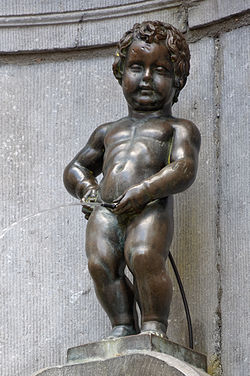
Back Manneken Pis Afrikaans مانيكن بيس Arabic تمثال مانيكين بيس ARZ Manneken Pis AST Manneken Pis BCL Манекен Пис Bulgarian Manneken Pis Breton Manneken Pis BS Manneken Pis Catalan Manneken Pis CEB
| Manneken Pis | |
|---|---|
 | |
 Location within Brussels | |
| Artist | Jérôme Duquesnoy the Elder |
| Year |
|
| Type | Bronze |
| Subject | Puer mingens |
| Dimensions | 55.5 cm (21.9 in) |
| Location | City of Brussels, Brussels-Capital Region, Belgium |
| 50°50′42″N 4°21′00″E / 50.8449861°N 4.3499932°E | |
| Website | Official website |
Manneken Pis (Dutch for 'Little Pissing Man'; Dutch: [ˌmɑnəkə(m) ˈpɪs] ⓘ) is a landmark[1] 55.5 cm (21.9 in)[a] bronze fountain sculpture in central Brussels, Belgium, depicting a puer mingens; a naked little boy urinating into the fountain's basin. Though its existence is attested as early as the mid-15th century,[2] Manneken Pis was redesigned by the Brabantine sculptor Jérôme Duquesnoy the Elder and put in place in 1619.[3][4][5] Its stone niche in rocaille style dates from 1770.[6][4] The statue has been repeatedly stolen or damaged throughout its history. Since 1965, a replica has been displayed,[7] with the original stored in the Brussels City Museum.[4][8]
Manneken Pis is one of the best-known symbols of Brussels and Belgium, inspiring several legends, as well as numerous imitations and similar statues both nationally and abroad.[9][10] The figure is regularly dressed up and its wardrobe consists of around one thousand different costumes. Since 2017, they have been exhibited in a dedicated museum called Garderobe MannekenPis.[11][12] Owing to its self-derisive nature, Manneken Pis is also an example of belgitude (French; lit. 'Belgianness'),[13] as well as of folk humour (zwanze) popular in Brussels.[14][15]
Manneken Pis is approximately five minutes' walk from the Grand-Place/Grote Markt (Brussels' main square), at the junction of the Rue du Chêne/Eikstraat and the pedestrian Rue de l'Étuve/Stoofstraat.[5] This site is served by the premetro (underground tram) station Bourse/Beurs (on lines 3 and 4), as well as the bus stop Grand-Place/Grote Markt (on lines 33, 48 and 95).[16][17][18]
- ^ "Brussels Landmarks and Monuments: Brussels-Capital Region, Belgium". www.world-guides.com. Retrieved 2 February 2018.
- ^ Deligne 2008.
- ^ Miller 1998.
- ^ a b c De Roose 1999, p. 20–23.
- ^ a b De Vries 2003, p. 51–54.
- ^ Des Marez 1918, p. 144.
- ^ Willsher, Kim (6 August 2015). "Fake pisstake? Scientists re-examine Belgium's celebrated Manneken Pis". The Guardian. Retrieved 7 June 2017.
- ^ Couvreur, Deknop & Symons 2005, p. 26.
- ^ Couvreur, Deknop & Symons 2005.
- ^ Emerson 2015.
- ^ Cite error: The named reference
:0was invoked but never defined (see the help page). - ^ Cite error: The named reference
:2was invoked but never defined (see the help page). - ^ Bainbrigge, Susan (2009). Culture and identity in Belgian francophone writing: dialogue, diversity and displacement. Peter Lang. ISBN 978-3-03-911382-8.
- ^ State 2004, p. 356.
- ^ "ZWANZE: Définition de ZWANZE". www.cnrtl.fr (in French). Retrieved 2 February 2018.
- ^ "Ligne 33 vers DANSAERT - stib.be". www.stib-mivb.be. Retrieved 23 July 2023.
- ^ "Ligne 48 vers ANNEESSENS - stib.be". www.stib-mivb.be. Retrieved 23 July 2023.
- ^ "Ligne 95 vers GRAND-PLACE - stib.be". www.stib-mivb.be. Retrieved 23 July 2023.
Cite error: There are <ref group=lower-alpha> tags or {{efn}} templates on this page, but the references will not show without a {{reflist|group=lower-alpha}} template or {{notelist}} template (see the help page).
© MMXXIII Rich X Search. We shall prevail. All rights reserved. Rich X Search